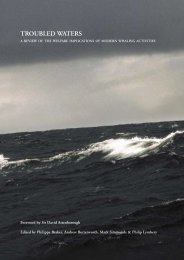Proceedings of the Untangled symposium: - WSPA
Proceedings of the Untangled symposium: - WSPA
Proceedings of the Untangled symposium: - WSPA
Create successful ePaper yourself
Turn your PDF publications into a flip-book with our unique Google optimized e-Paper software.
Annex 4Submitted abstracts accompanyingposter presentationsresponse to <strong>the</strong>se entanglements cases as <strong>the</strong>y pose acomplex logistical and safety planning process in orderto successfully carry out <strong>the</strong> disentanglement <strong>of</strong> <strong>the</strong>seanimals followed up with a prevention mechanism formarine debris.Whale Shark Conservation Project along <strong>the</strong> GujaratCoast <strong>of</strong> IndiaManoj Matwal, Pr<strong>of</strong>. B.C. Choudhary, Dr. Rahul KaulWildlife Trust <strong>of</strong> IndiaB-13 Sector 8 , Noida 201301, Uttar Pradesh, Indiamanojmatwal@gmail.comThe Whale Shark Conservation Project in India is aninitiative <strong>of</strong> <strong>the</strong> Wildlife Trust <strong>of</strong> India in collaboration with<strong>the</strong> Gujarat Forest and Wildlife Department supported by<strong>the</strong> corporate Tata Chemicals. In <strong>the</strong> largest congregatingcoast <strong>of</strong> Gujarat <strong>the</strong> whale sharks were a victim <strong>of</strong>non-targeted incidental catch in <strong>the</strong> marine fisheriesand a targeted export oriented hunting. Placement <strong>of</strong><strong>the</strong> species under Wildlife Protection Act <strong>of</strong> India, anda fisherman targeted Awareness Campaign brought<strong>the</strong> hunting level to zero. Implementing a net damagecompensation scheme based on a rescue programfrom December 2006, a total <strong>of</strong> 306 whale sharks hasbeen rescued till March 2012.The research experienceand lessons during <strong>the</strong>se rescue operations includesunderstanding <strong>the</strong> physiological requirements such asram ventilation osmoregulation and stress factors <strong>of</strong><strong>the</strong> species. Based on this a new self-documented andrescue protocol has been developed to minimize <strong>the</strong>delay in rescues, giving better chances <strong>of</strong> survival toWhale sharks.Lack <strong>of</strong> scientific information, and some resilience from<strong>the</strong> authorities came as a hurdle but continuous effortsby a dedicated team managed to turn <strong>the</strong> situation infavor <strong>of</strong> whale shark. Such kind <strong>of</strong> marine related rescueprograms should be conducted under proper scientificknowledge, timely reviewed by <strong>the</strong> experts.Welfare aspects <strong>of</strong> marine mammal entanglementin fishing gearMichael MooreBiology Department, Woods Hole OceanographicInstitutionWoods Hole, MA 02543, USAmmoore@whoi.eduOn <strong>the</strong> eastern seaboard <strong>of</strong> <strong>the</strong> United States andCanada, large whales, dolphins, porpoises and seals allget entangled in fishing gear. An annual average <strong>of</strong> 2773whales, dolphins and seals died in fishing gear in <strong>the</strong> NWAtlantic waters <strong>of</strong> <strong>the</strong> United States for <strong>the</strong> period 2005to 2009. Our goal has been to document <strong>the</strong> extent andnature <strong>of</strong> <strong>the</strong> problem from a welfare perspective. Theprimary marine mammal entanglement scenario involvesactively fished gear. Where such gear is torn away by<strong>the</strong> power <strong>of</strong> <strong>the</strong> animal, or <strong>the</strong> entangled animal is cutout from <strong>the</strong> gear by <strong>the</strong> fisher it could be defined at thatpoint as debris. Such material includes: rope, traps andfloats from fixed trap fisheries, especially lobster gear,gillnet and its associated ropes and floats, mon<strong>of</strong>ilamentand braided hook and line fishing gear, and mobile trawlgear. Such materials can also all entangle after beingdiscarded as primary debris. Harm inflicted can include:asphyxiation through subsurface entrapment; or if <strong>the</strong>animal can surface, it can remain anchored in place;or if it is cut free, or can break away, <strong>the</strong> result may bechronic entanglement, with resultant laceration, incision,constriction, feeding impairment, increased drag, loss <strong>of</strong>body condition, bony proliferation, infection and ultimatedeath. Time from first entanglement to death can rangefrom minutes to years. Symptoms likely include acutedistress in cases that cannot surface and <strong>the</strong>reforedrown at some time after <strong>the</strong> normal dive duration,which ranges from minutes to more than an hour in<strong>the</strong> case <strong>of</strong> some whales. Chronic cases presumablysuffer from severe and chronic pain, similar to thatseen in compartment syndrome in terrestrial mammals.Diagnosis <strong>of</strong> acute drowning entanglement <strong>of</strong>tendepends on subtle surface markings form<strong>the</strong> gear, airway froth and systemic congestion,suggestive <strong>of</strong> a terminal struggle. Chronic entanglementcases <strong>of</strong>ten show resultant wounds and emaciation.Management attempts to prevent <strong>the</strong>se entanglementsinclude seasonal closures, gear modification, such asweak links and sinking groundlines, and acoustic deviceson gillnets. Efforts to ameliorate <strong>the</strong> effects post facto58
















